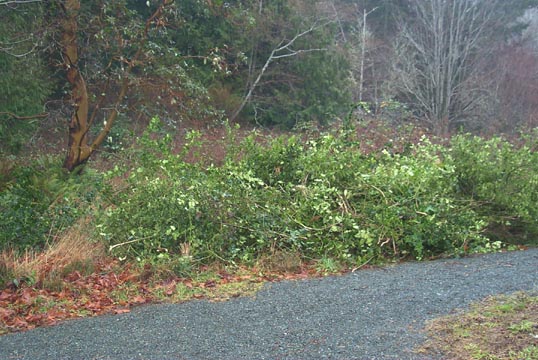Removing Invasive Species
There are several areas of English Holly infestation in the park. Birds, particularly robins, eat the holly berries and the berry seed coatings are etched as they pass through the bird's digestive tract. Germination is thereby facilitated and the seedlings have become established as a significant understory element in some western portions of the park. In some situations English Holly has displaced native species such as Pathfinder as the plants, which are shade tolerant, spread by underground runners. Dispersal is mainly by runners because most of the English Holly plants do not bear berries in shaded situations until they become mature trees. Digging out the roots and runners is laborious and time consuming, but necessary to protect native plant habitat. This creates quite a bit of soil disturbance which leaves open ground vulnerable to exploitation of remaining holly or other opportunistic species. One solution is to try to get other native species established as soon as possible.
Several trees in the park are infested with English Ivy which is also shade tolerant, and in time starts to spread across the ground by runners and overwhelms native species. Cutting the vines at the tree's base will kill the vines, but the tendency then is for English Ivy to spread by runners, so digging out the roots and runners at the tree's base is important.
Work parties were arranged in November, 2013 and March, 2014 to remove holly, ivy and daphne. After each event a potluck lunch was held across the road from the park at Richard Snyder's home.

This pile of holly is from the the first work party. The holly was later removed and burned.

The holly from the second work party was burned on site with the help of Cam Woodsend from the CRD.

Dave Bigelow from the East Sooke Volunteer Fire Department was on hand to ensure the fire was kept under control.

The original pile size is shown by the brown circle.
It should be mentioned that there is no strategy for the removal of Himalayan Blackberry vines which form thickets around the parking lot. The vines provide a good harvest of blackberries each summer and are valued by both wildlife and humans, as are the fruit of the apple and pear trees growing near the parking lot.
Other invasive species are of concern, including non-native thistles and Tansy Ragweed. Both are shade intolerant and are present around the parking lot area, but can be removed concurrently with the English Holly and English Ivy. Broom and Daphne removal will also be ongoing at a maintenance level, mostly involving removal of seedlings. Removal of Helleborine Orchids (Epipactis helleborine) will also have to be ongoing since these weedy European orchids can displace native orchids.